Wednesday, December 19, 2012
Wednesday, September 12, 2012
Forgotten Souls
Forgotten Souls
Written by Caeli MacLennan

Goode, Ben. Global warming timeline.
Dreamstime. Web. 12 Sept. 2012. <Dreamstime.com>.
“Help! Help! HELP!” I scream at the
top of my lungs, clawing uselessly at the pile of boulders covering the small
tunnel that was my only way of escape, praying that someone might be able to
hear me; the only response is the echo of my own voice, ricocheting off the
damp cave walls. Help, help, help the
walls whisper back, mocking my efforts. I continue to scream and claw and kick
and pound at the stones, until my voice is hoarse and my body bruised,
battered, and bleeding. With a sob of despair, I slide down against the cave
wall, resting my stinging fists on my knees. Struggling is pointless; I’m an
idiot for wasting my last moments on it. Once trapped inside, no one escapes
the caves. Ever.
Burying my face in my knees, my wails
echo off the cave walls, rising in a crescendo sounding not like the cries
of one girl, sitting alone waiting for death, but like that of a village during
a terrible plague, when the old and young die; those remaining not yet grown
left alone to fend for themselves. This disturbing sonata continues to grow and
thrive, only increasing my fear and adding fuel to the growing music. It is not
until my voice is hoarse and raw that the wails finally die down to whimpers,
barely audible through my trembling knees.
When my eyes have been cried dry, I
raise my head and look for a source of light that I know isn’t there. I’d heard
of people being trapped before, but never had I dreamt it would happen to me. I
begin to wonder what it is said all caught ones wonder about in their last
moments; how will I die? Will the air run out? Will I suffocate? Will the tide
come in and I drown? Perhaps the sun will come out and I’ll bake in here, or maybe
time will pass and I’ll just starve to death.
As I ponder the possibilities of my imminent
demise, I wonder what the village will think back home when I don’t return.
Will they assume that I perished while scavenging for food, or will they even
notice my absence at all? I know my grandmother and younger twin siblings would
never forget me, though without the supplies I bring in, I’m not sure how long
they’d last. The thought of being completely forgotten, washed away from the
fabric of time, frightens me almost as much as dying in here. Grandmother would
tell me nobody really dies, that they live on in the hearts of others. But what
happens if there’s nobody left to remember you?
Then it hits me: what if I won’t be
forgotten? What if I live on, not in the hearts of those who knew me, but in
the minds of some distant people in the future who happen to stumble across my ancient
skeleton? Quickly, not daring to waste another moment, I dig into my backpack
and whip out a notepad and pen, hand poised to strike the empty page at any
given moment. I pause; this is it, my impact on the world, my gift to the human
race. And so I begin to write.
July 26th, 2456
Dear Journal,
Hello.
My name is Catherine Angelee Lockhart; I have been lucky enough to reach the age
of fourteen and have lived in the nearby village of Portum with my grandmother
and twin younger siblings. Well, I used to live there. My life is nearing an
end, and my last remaining family members are sure to follow. Trapped in this
cave, I have decided to spend my last moments, whether they be hours or days,
recording my memories in hopes that I will not be forgotten; so that I may live
on in the hearts and minds of others. And so, without further delay, I shall
begin.
Portum
was the name bestowed upon my village when the first survivors from the dark
ages built it in the year 2209. It means haven in Latin, and perhaps those who
have experienced life outside its borders view it as such. However, in my eyes,
Portum is one of the least hospitable places a poor, tired old sap could
stumble across. Our shacks are squished together so that one home can hardly be
differentiated from the other; the only distance between them are tiny walkways
separating each row, wide enough for a mere three people to walk side by side.
Each shack has a low ceiling with scarcely enough room for two traditional beds;
each housed at least four, while some as many as ten. Walking through the
streets, you see the small grimy forms of children peeking out from behind
cloth doorways, their sunken eyes staring mournfully from skull-like faces. This
is their way of begging; for scraps, clothes, anything really. Their eerie gaze
follows you as you pass by, almost hungrily. No one ever helps, though. In
Portum, everyone fends for themselves; only the strongest survive.
That’s
the opposite of my family right now. Grandmother is ancient; she must be 56 by
now. As for my younger siblings, Amber and Coal, they were both born weak and
sickly. It’s almost unheard of for a mother to have twins nowadays, ever since
the crops failed. Most of the old stories I’ve salvaged from the ruins of
houses and libraries act like a single catastrophic event is what blotted out the
sun and tore apart mankind. But the real way it happened was much slower,
agonizing, humiliating even. Our ancestors were careless and naïve. Life was
too easy for them; an escape could be easily provided by looking the other way.
They had no idea the future their ignorance brought upon us. If they had only
been less selfish and lazy, maybe Portum could live up to its name. Because of
the extreme amount of carbon dioxide that was sent into our atmosphere, the
earth is warmer than ever. Seas have risen to flood our lands and areas where
it was warm before are now barren desert wastelands. Refugees flocked to places
like Portum for a hundred years before the flow finally stopped.
Overcrowding
has been the end of many a village. A large population in small spaces makes
cleanliness difficult and diseases remarkably easy to spread. Plagues are the
leading cause for a community’s demise; a close runner up is starvation. Any
attempts at agriculture are futile now that the sun is cloaked by gray cloud
cover every day. Food has to be scavenged from the old ruins surrounding the
village, which can be dangerous and, after two hundred years of searching, less
than fruitful. It is the reason why Amber and Coal will never live to
adulthood; their mother simply didn’t have enough strength to give, even if she
relinquished her own life so they could have theirs.
Ever
since mom’s death four years ago, I’ve taken up life as a scavenger. Out of the
few ways to make a living, scavenging is the most dangerous. A wrong move can
get you killed faster than you can say shoot. But it was the only way for me to
support my grandmother and two sickly children. That was how I ended up like
this; stuck in a cave, waiting for the oxygen to run out. There’s this legend
that some lady from the 21’st century was paranoid about a food shortage, so
she stored a whole villages worth of canned goods deep inside a cave near Portum.
Supposedly, the old woman died before she ever got a chance to use any of it,
and no one’s found it since. I figured if I found her secret stash, I’d never
have to scavenge again, and Amber and Coal would sleep soundly, not having to
worry that the sister that cared for them so much as to risk her life wouldn’t
be there come morning.
Now
that dream is gone. I’ll never again see the smiling faces of Amber and Coal,
feel their tugging hands as they pester me to tell them a story before bed,
watch them huddled together as one pair of sleepy eyelids begins to droop, then
the other, and before you know it, they’re both asleep on the floor, snoring
lightly. I’ll never be able to hear any more wisdom from my grandmother or feel
her wrinkly old arms embrace me as she kisses my cheek goodbye each morning. There
is only one fate left for us now; leave this world, never to return. No one is
going to save us. My vision of two smiling children stuffing their faces with
bits of pineapple while grandmother scolds them about manners, is impossible.
And so, in order to grant myself some solace in my last moments, I have one
last plea before I die, and that is to not be forgotten. Whoever you are,
whether it be a hundred or a thousand years from now, remember the words I have
written today. Do not forget the world I speak of or the mistakes of our
ancestors, for though I may be long dead, I am real, and these problems are
real. Refusing to acknowledge an issue does not solve it; it only provides a
safe place for it to grow and thrive until it is no longer within man’s
capabilities to control. Remember this, and I will rest in peace.
With hope,
Catherine Angelee Lockhart
My fingers shake as the pen slides
from their grasp, rolling down the notebook and hitting the floor with a soft
clunk. Hurriedly, I stuff the journal into a plastic bag, drain the air, and
seal it shut. This way it won’t be damaged when the tide comes in. Stuffing the
journal back into my bag, I remove the blanket I found from a scavenge earlier
that day and find the most comfortable position to spend my last moments. I
know now that it’s suffocation that will take me; it’s an effort to perform
even the smallest tasks, and my eyes feel droopy. It’s strange, but in a way I feel
remarkably peaceful. I begin to wonder, what if it’s not so bad that
grandmother, Amber, Coal, and I are dying? What if death would provide an
escape from this rotten world, take us to another place where my twin siblings
can run and play in vast meadows, and grandma can sit in a rocking chair,
conversing with my mother about the afterlife like she always used to. “I told
you so”, she’d say smugly. “There’s always a place for people who are
remembered.”
The
more I think about it, the more it doesn’t seem so bad. Suddenly a grin spreads
across my face and I begin to sing, a melody I sang to the twins when they had
bad dreams. The music echoes throughout the cave, harmonizing beautifully with
itself as the verses weave together to create melodies fit for angels.
Hushaby, my sweet little baby
Forget your fears and doubts
For somewhere, far over the rainbow
Lies the land of Sonisoe.
There the day sky’s blue as an iris,
The night sky’s pricked with light
There the fruit trees blossom with cherries
That bring a smile of delight
During daylight children play
During nighttime they dream sweet
So fall to sleep, so that one day dear,
There again we still may meet
My eyelids are hard to keep open now,
and more than anything I want to succumb to the blackness, but for some reason,
the song must finish.
So hushaby, my sweet little baby
Dream the good dreams now
And know, that if you ever may need me
I’ll be there in Sonisoe
The last verse is sung with my eyes
closed, the music reverberating off the walls and singing to me the lullaby
that will guide me to an eternal slumber.
When the time is right, my baby
Your dreams will take you there
I’ll miss you dear, but not to worry
We’ll meet again in Sonisoe
Monday, August 6, 2012
Faded Dreams
Faded Dreams
I once dreamt of a place
a sanctuary, a haven
where the Earth was cool and soft
a summer nights breeze blew gently through the meadow
making the grass ripple and shimmer
like the waves of the sea.
The clear indigo sky was scattered with thousands
of shining specks
glimmering in an eternal darkness.
a sanctuary, a haven
where the Earth was cool and soft
a summer nights breeze blew gently through the meadow
making the grass ripple and shimmer
like the waves of the sea.
The clear indigo sky was scattered with thousands
of shining specks
glimmering in an eternal darkness.

A full moon cast a silver veil over the peaceful scenery
reflected in the mirror of a trickling pond
with flashing fireflies flickering over placid waters.
As I lay sprawled on the soft, moist bed
gazing upon twinkling stars
inhaling deeply the crisp night air
I spot a dark figure swoop across the midnight sky
and smile in anticipation of seeing again
my friend, guardian, and gateway to this sacred oasis
She is so beautiful, my guardian
moth dust silver eyes and pearlescent horns gleaming in the moonlight
bat-like wings folded delicately at her sides.
Trotting towards me on four furred paws,
marble claws digging into the soil,
her head held high in regal grace,
she lowers it to nuzzle my cheek
telling me it is time to go.
I rise from my resting place, climb upon her back
and nestle my head in her silky, indigo-violet fur
as she takes off, soaring up,
up into the wind, the heavens
the meadow shrinking to a minuscule dot
then vanishing into the forest that we glide above now.
The air flailing my short blond curls wildly behind my head
makes me throw up my arms and revel in my freedom,
the irreplaceable joy that fills you up, makes your face glow, eyes twinkle
causing your lids to shut, a silly grin plastered on your face
and, for just one moment in our troubling lives,
to be truly, purely, and unexplainably happy.
Looking back upon that moment,
that amazing, incredible, spectacular moment that occurred deep within my brain,
I realize now that I couldn’t have savored it enough
for, though innocence kept me from knowing then,
I would only reach my sanctuary a few more times,
until, like tar devouring a wailing infant,
it, along with the rest of my world,
melted into the abysmal void
that plagues me as I slumber.
~Caeli MacLennan
Picture by: Ordinary Day. 2010. private collection. Web. 6 Aug.
2012.
<http://artandmusicappreciation.blogspot.com/2012_03_01_archive.html>.
Sunday, July 29, 2012
Sunday, July 8, 2012
Why Go Organic?
Imagine this: Helen, a mother with
three children, is shopping at the grocery store to buy food for her family.
Strolling through the produce section, her eyes scan the many crates, pondering
over which brand of apple would suit her household best; they come to rest on a
pink label that reads, “organic”. Scowling at the price tag, she wonders, why should I pay extra money for something
that is organic? I mean, what’s the difference? In truth, there are
actually great quantities of reasons why organic foods are preferable to non-organically
grown foods: they are healthier, better for the environment, and are grown
without pesticides.
One little known fact about organic
foods is that they contain more vitamins, minerals, and antioxidants than non-organically
grown foods. Why? The reason is actually quite simple. Plants produce
antioxidants when placed in stressful conditions, such as becoming prey to a
predator. Because inorganic foods are grown with pesticides, they don’t have to
deal with the nuisances and therefore do not produce the antioxidants needed to
help them through such situations. Because organic foods are exposed to all of
nature’s obstacles, they are put in greater distress and, in turn, produce more
antioxidants, which are known to help fight cancer. When tested, organic foods
also are shown to contain higher levels of vitamin C, calcium, magnesium, iron and chromium
than non-organically grown foods.

Another reason to go organic is
because organic farming is better for the environment than non-organic farming.
Many non-organically grown foods are shipped all across the world, sometimes
sitting in crates for multiple days in one trip. Sending the goods to all these
different places uses an immense amount of fuel. Not only does the shipping of
the produce require an enormous amount of energy, but the shipment of the fertilizer
as well as its production requires so much fossil fuel that we are practically
eating it. Also, because of the time needed to ship fruits and vegetables to
their destination, most of the goods are harvested before they are ripe in
order to ensure that they are not rotten when they arrive. Because they don’t have
the opportunity to ripen on the vine, non-organically grown foods will
often possess less flavor than organic foods, causing 53% of the U.S to dislike
them.
Perhaps
the most crucial reason that many people choose to buy organic foods despite
expensive price is that non-organically grown foods, instead
of using natural means to keep animals and pests away, spray pesticides on the
produce, essentially covering them in a thin layer of poison. Animals, such as
birds, that are unfortunate enough to make the mistake of nibbling on a non-organically
grown fruit
or vegetable suffer severe consequences, and if they don’t die soon after their
error, their offspring will be born unable to survive in the harsh wilderness.
In addition to the direct poisoning of animals that eat the unsafe foods, indirect
poisoning occurs when pesticides are washed by rainwater into rivers, which
affect fish and other wildlife. Not only are small animals affected, but many humans
who eat the foods are also in harm’s way. As many as seven of the most toxic
chemical compounds known to man are approved to be used as pesticides by the CAC
(Codex Alimentarius Commission) and which the
residues of are commonly found, as well as many other pesticide residues, in
baby foods, spinach, dried fruit, bread, apples, celery, and chips. Although adults can experience symptoms as well, children
are the most prone to the dangers of nonorganic farming. Birth defects, cancer,
hormone disruption, neurological effects, and asthma are all common effects of
these poisonous residues.
In conclusion, organic foods are healthier, safer, and better for the environment
than non-organically grown alternatives.
Although many people are fooled into buying the cheaper and often larger choices,
those who have outsmarted the price tag find that they lead happier, healthier
lives because of their decision. Don’t fall prey to the dangers that inorganic
foods present; buy organic produce as often as possible, particularly when
shopping for children.
Citations:
"Shocking Reasons to go Organic." Online
Newspaper. CBS News, 16 Mar. 2010. Web. 7 July 2012. <http://www.cbsnews.com/2100-500398_162-6303444.html>.
"Health Effects of Pesticides." Kids for Saving
the Earth. N.p., n.d. Web. 8 July 2012.
<http://www.kidsforsavingearth.org/mnchec/articles/pesticides.htm>.
"Effects of Pesticides."
Global healing Center. N.p., n.d. Web. 8 July 2012. <http://www.globalhealingcenter.com/effects-of-pesticides/effects-of-pesticides>.
"Ten reasons why you should go organic." Organic
Consumers Association. N.p., 3 Sept. 2006. Web. 8 July 2012.
http://www.organicconsumers.org/articles/article_1944.cfm.
The Dirty Dozen: When to go organic. Private
Collection. Web. 8 July 2012.
<http://yuru.com/blog/2010-07-the-dirty-dozen-when-to-go-organic>.
Sunday, June 10, 2012
A Hundred Years from Now
A Hundred Years from Now
What will life be like, a hundred years from now?
What troubles my grandchildren shall face
what life they shall live
what joys they be blessed
what tiresome struggles shall put them to test
a hundred years from now?
What troubles my grandchildren shall face
what life they shall live
what joys they be blessed
what tiresome struggles shall put them to test
a hundred years from now?
What will life be like, a hundred years from now?
When I have passed away
will trees grow on rooftops
cars soar above seas
cities float atop clouds that blow in the breeze
a hundred years from now?
When I have passed away
will trees grow on rooftops
cars soar above seas
cities float atop clouds that blow in the breeze
a hundred years from now?
What will life be like, a hundred years from now?
If the blue and green Earth turn gray.
Will the swallows that twitter
the bluebirds that sing
disappear in a flash without taking a wing
a hundred years from now?
If the blue and green Earth turn gray.
Will the swallows that twitter
the bluebirds that sing
disappear in a flash without taking a wing
a hundred years from now?
What will life be like, a hundred years from now?
I’m afraid I’ll be too old to tell.
But hopefully someone
who struggles and fights
for the very same reasons that bring the earth light
will still be there, out somewhere
a hundred years from now.
I’m afraid I’ll be too old to tell.
But hopefully someone
who struggles and fights
for the very same reasons that bring the earth light
will still be there, out somewhere
a hundred years from now.
~Caeli MacLennan
Tuesday, May 22, 2012
Living Streetlights?
Imagine this: the sun is setting
and it’s about time for the streetlights to light up, one by one, bright bulbs casting
yellow circles of light on the dark sidewalk below. However, as evening settles
in, it is not the dirty electric bulbs that illuminate the street; instead, a
ghostly blue light fills in the dark crevices, giving the street a magical
aura. In certain places, the captivating cave-like glow is replaced by a soft
golden light that radiates from above. The previously dull street is
transformed into something out of a dream.
Recently, students at Cambridge University
have discovered a way to insert the bioluminescent genetics found in fireflies
into other organisms. The first organism that went through this procedure was a
tobacco plant. Not only did the students successfully make the plant glow, but also
modified the bioluminescent genetics so that the produced light was bright
enough to read by. An idea has been proposed to do the same with trees in order
to replace streetlights, and although the research required to do so would be
fairly expensive, the result could potentially reduce the amount of money spent
on electricity as well as the human impact on the environment.
Taiwanese researchers have come up
with a similar idea. Their “living streetlights” are made using gold nanoparticles.
The nanoparticles are inserted in the leaves of the tree, causing the tree to
give off a bright reddish glow which could be used in place of streetlights to
light the sidewalks at night. Not only do the nanoparticles provide light
without electricity, but they also cause the trees to photosynthesize while
they are lit which removes CO2 from the air. The expenses for this project
however are extremely high, as gold nanoparticles are made from real gold which
is very expensive. High prices set aside, these living lights are a potential
replacement for common streetlights that are used today.

Bioluminescent trees illuminate the street
photo:http://www.newscientist.com/article/mg20827885.000-glowing-trees-could-light-up-city-streets.html

A bioluminescent christmas tree
photo: http://www.isbc.unibo.it/Files/IM_013.htm

a genetically engineered bioluminescent tobacco plant
photo: http://www.sciencebuzz.org/museum/object/2008_07_plants/dead
 Gold nanoparticles
Gold nanoparticlesphoto: http://bldgblog.blogspot.com/2010/11/gold-is-metal.html courtesy of Georgia tech
Sources:
For more information, please visit the websites listed above
Wednesday, February 15, 2012
New Power Supply for Car Batteries?
Earlier in this blog, both the ideas of micro wind turbines and new, clean sources to power vehicles have been addressed. The current solution experts are trying to come up with for the amount of pollution that cars are producing is to power them with hydrogen, though, as we have seen in an earlier article, has it's flaws. But what if we could find another source to power automobiles? Micro wind turbines are small and can withstand even the worst of weather conditions. So why not mount them on vehicles? As the car drove, it would create high wind speeds that would turn the propellers of the turbine rapidly. If the Turbine was hooked up to the car battery, it may provide a sufficient supply of energy to power the car without the aid of gasoline. However, there are still questions that remain: Where will the turbines be mounted, and how will they be secured? Could a wind turbine be small enough to fit on a car (and still look sightly enough for people to purchase the car) and still produce a enough electricity to power the car?
I would like to hear other peoples' ideas on how we could make this work. Please post a reply with your thoughts.
Thank you Panda's Need to be Saved for this great idea.
I would like to hear other peoples' ideas on how we could make this work. Please post a reply with your thoughts.
Thank you Panda's Need to be Saved for this great idea.
Tuesday, February 7, 2012
Micro Wind Turbines
Did you know that a single wind turbine can generate enough electricity to power a small town? These massive propellers can be up to 160 meters (525) in height and have blades that are 40 meters long. That makes the diameter of the blades longer than a football field! However, there is a problem with these enormous energy making machines; they simply take up too much space. Not only do they require room for the turbines themselves, they also need to be spaced far enough apart that each turbine gets enough wind to turn its huge propellers. Recently, experts have invented a smaller, more practical version of these colossal turbines known as micro wind turbines. These are, as their name suggests, mini wind turbines small enough that they can be placed in areas such as the top of a roof. A micro wind turbine, on a windy day, can provide enough energy to light an average household. They can also generate power with wind speeds as low as 2 meters per second. Although these new turbines are becoming quite popular in great Britain, many people do not like them because they are "unsightly" and make too much noise. However, with a little time, micro wind turbines could become a common appliance in our every day lives.

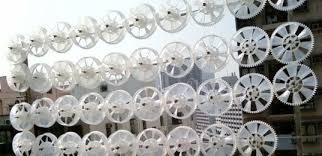
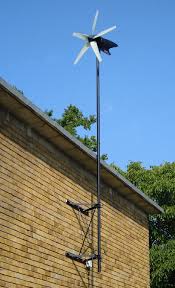
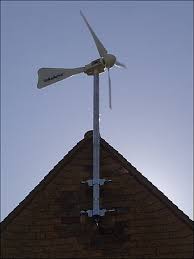
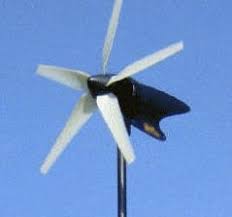
Monday, January 30, 2012
Hydrogen Cars: Vehicles of the Future
Hydrogen cars are vehicles that use hydrogen powered fuel cells instead of gasoline. These cars are environmentally friendly, as the only emissions they produce are heat and water (normally in the from of steam). So why doesn't everyone use these Eco-friendly cars?
One reason is that making these cars can be very expensive, and building refueling stations for them even more so. The fuel cells in a hydrogen car contain platinum, which is very costly. A single cell hydrogen car currently costs $100,000 or more. Those who are less than optimistic have estimated the cost for building an infrastructure that will allow a significant number of hydrogen cars to be as high as $500,000,000,000, and that it might take four decades for it to be complete.
Another issue with hydrogen is that it is highly flammable and is difficult to store. Since Hydrogen is a gas, it expands significantly with heat. Therefore, a car filled with hydrogen fuel sitting in the sun will have to vent some of the hydrogen. A car that is left like this will eventually have no fuel left. Hydrogen is also extremely flammable and is believed to be the cause for the explosion of the Hindenburg.
The third reason hydrogen may not be ideal is that it may not be as Eco-friendly as we think it is. There are two ways to produce hydrogen. One is to extract it from water and the other is to extract from a natural gas. The process used to remove hydrogen from water is called electrolysis. In this method, an electric current is run through the water, separating the hydrogen and oxygen atoms. The problem with using electrolysis is that much of the electricity used is produced by burning coal, which is causes pollution. The other way to get hydrogen, extracting it from natural gas, produces carbon as a bi-product, which is what we are trying to get rid of in the first place.
But what if we were able to find a way around these obstacles? Like using solar power instead of burning coal or finding a less expensive metal that can replace the platinum in fuel cells? At this very moment, experts are coming up with new ideas to make the hydrogen car more realistic, but it could be decades before an effective way of creating this vehicle is found, and decades more before it is put into action.
Please comment on this post if you have any ideas whatsoever on ways that might help the hydrogen car become a reality. Here is a link to an article that further discusses hydrogen cars and how they work. http://auto.howstuffworks.com/fuel-efficiency/hybrid-technology/hydrogen-cars3.htm

One reason is that making these cars can be very expensive, and building refueling stations for them even more so. The fuel cells in a hydrogen car contain platinum, which is very costly. A single cell hydrogen car currently costs $100,000 or more. Those who are less than optimistic have estimated the cost for building an infrastructure that will allow a significant number of hydrogen cars to be as high as $500,000,000,000, and that it might take four decades for it to be complete.
Another issue with hydrogen is that it is highly flammable and is difficult to store. Since Hydrogen is a gas, it expands significantly with heat. Therefore, a car filled with hydrogen fuel sitting in the sun will have to vent some of the hydrogen. A car that is left like this will eventually have no fuel left. Hydrogen is also extremely flammable and is believed to be the cause for the explosion of the Hindenburg.
The third reason hydrogen may not be ideal is that it may not be as Eco-friendly as we think it is. There are two ways to produce hydrogen. One is to extract it from water and the other is to extract from a natural gas. The process used to remove hydrogen from water is called electrolysis. In this method, an electric current is run through the water, separating the hydrogen and oxygen atoms. The problem with using electrolysis is that much of the electricity used is produced by burning coal, which is causes pollution. The other way to get hydrogen, extracting it from natural gas, produces carbon as a bi-product, which is what we are trying to get rid of in the first place.
But what if we were able to find a way around these obstacles? Like using solar power instead of burning coal or finding a less expensive metal that can replace the platinum in fuel cells? At this very moment, experts are coming up with new ideas to make the hydrogen car more realistic, but it could be decades before an effective way of creating this vehicle is found, and decades more before it is put into action.
Please comment on this post if you have any ideas whatsoever on ways that might help the hydrogen car become a reality. Here is a link to an article that further discusses hydrogen cars and how they work. http://auto.howstuffworks.com/fuel-efficiency/hybrid-technology/hydrogen-cars3.htm

Saturday, January 28, 2012
The BP Oil Spill
These are some photographs of the effects that the oil spill has had on the evironment. A thick layer of oil coats the feathers of these birds, making them unable to fly. People are making an effort to save the birds by capturing them and cleaning thier feathers with bleach. Sadly, it is often too late to save these victims. Some birds who were effected by the spill while returning to their nests will not go back to care for their young after being cleaned.
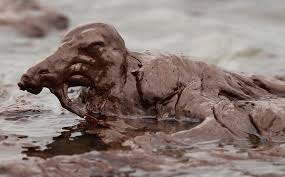




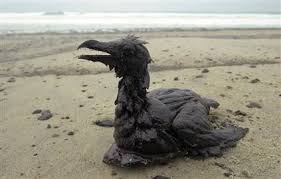

Subscribe to:
Posts (Atom)


